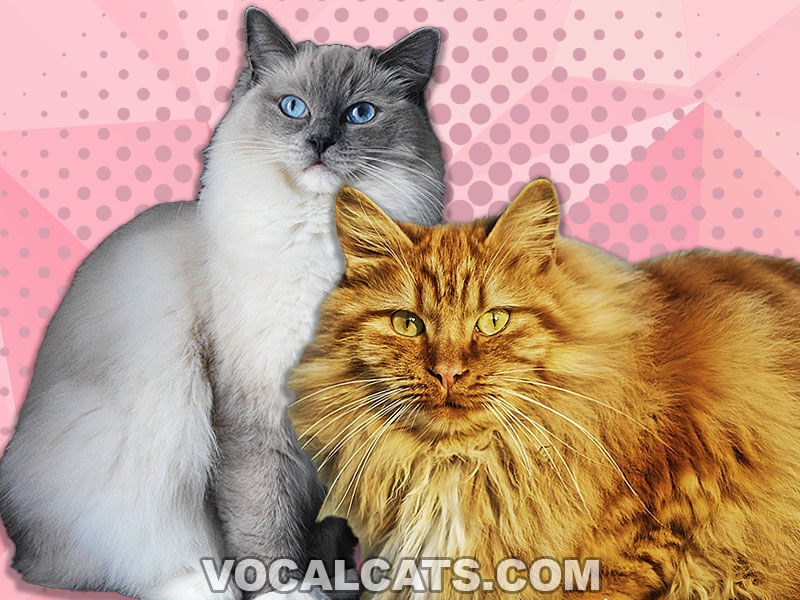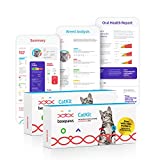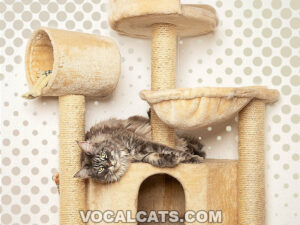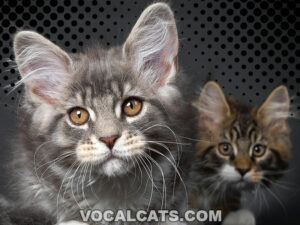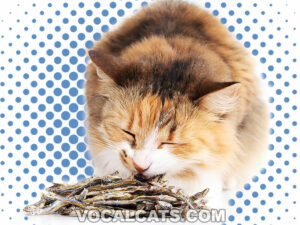Ragdolls, being one of the popular cat breeds in town, continue to fascinate cat lovers with their sweet and cuddly nature. It is not surprising then that some breeders mix this purebred with another equally charming breed such as a Norwegian Forest cat to produce a mix called a Ragdoll Norwegian Forest Cat Mix.
If a large designer cat breed fancies you, a Ragdoll cross with a Norwegian Forest cat may be the perfect one for you. This cat is not only big but has a big loving heart to share with those who want to care for it.
Of course, other designer cat breeds are perfect for families such as a Maine Coon Ragdoll Mix. But for today, it’s all about learning more about the history, physical appearance, proper care, and where you can get a healthy Ragdoll Norwegian Forest Cat Mix.
Contents
- Ragdoll Norwegian Forest Cat Mix: Breed overview
- What is a Ragdoll Norwegian Forest Cat Mix?
- Norwegian Forest Cat Ragdoll Mix: Parent breeds
- How can I tell if my cat is part Norwegian Forest Cat?
- What two breeds make a Ragdoll cat?
- How do you tell if my cat is a Ragdoll mix?
- Norwegian Forest Cat vs Ragdoll
- Do Norwegian Forest cats get along with Ragdolls?
- Are Ragdoll Norwegian Forest Cat recognized by cat registries?
- Norwegian Forest Cat Mixed with Ragdoll physical appearance
- Ragdoll and Norwegian Forest Cat Mix size, height, and weight
- Ragdoll Norwegian Forest Cat Mix coat colors and types
- Tuxedo Ragdoll Norwegian Forest Cat Mix
- Norwegian Forest Cat Ragdoll Mix personality and temperament
- Do Ragdoll Norwegian Forest Cats make great family pets?
- Norwegian Forest Cat Mixed with Ragdoll training
- Ragdoll and Norwegian Forest Cat Mix exercise requirement
- Ragdoll Norwegian Forest Cat Mix grooming and cleaning
- Do Norwegian Forest Cat Ragdoll Mix shed a lot?
- Are Ragdoll Norwegian Forest Cat Mix hypoallergenic?
- Ragdoll Norwegian Forest Cat food and diet
- Ragdoll Norwegian Forest Cat Mix common health issues
- Ragdoll Norwegian Forest Cat Mix lifespan
- Norwegian Forest Cat Mixed with Ragdoll breeders
- Ragdoll Norwegian Forest Cat Mix kittens
- Norwegian Forest Cat Ragdoll Mix price
- Places to find Ragdoll Norwegian Forest Cat Mix for sale
- Similar Ragdoll Norwegian Forest Cat Mix
- Maine Coon vs Ragdoll vs Norwegian Forest Cat
- Ragdoll Norwegian Forest Cat Mix: Pros and Cons
- Is the Norwegian Forest Cat Ragdoll Mix right for me?
- Related Questions
Ragdoll Norwegian Forest Cat Mix: Breed overview
| Other names | Wegie Ragdoll |
| Size | Large |
| Weight | 10 – 20 pounds |
| Height | 9 – 12 inches |
| Coat Colors | Black, White, Seal, Blue, Chocolate, Red, Cream, Lilac |
| Child Friendliness | High |
| Feline Friendliness | High |
| Training Difficulty | Moderate |
| Grooming Upkeep | High |
| Exercise Needs | Moderate |
| Health | Moderate |
| Lifespan | 12 – 18 years |
| Kitty Costs | $800 – $2,000 |
RECOMMENDED: Maine Coon Norwegian Forest Cat (Complete Guide)
What is a Ragdoll Norwegian Forest Cat Mix?
A Ragdoll Norwegian Forest Cat Mix is a large domesticated cat that is a cross between the heavily-coated Norwegian Forest Cat and the blue-eyed, color pointed Ragdoll.
You may be interested in: Lilac Ragdoll (Complete Guide)
Norwegian Forest Cat Ragdoll Mix: Parent breeds
To know more about the Norwegian Forest Cat Ragdoll Mix, it is best to take a glimpse into each of their parents. This is to give us a clue on how physically and temperamentally this mix would turn out.
Nicknamed the Wegie in the United States, the Norwegian Forest Cat is a large, well-muscled domesticated cat possessing considerable girth.
Their water-resistant double coat comes in a variety of colors and patterns that can withstand the harsh winters of northern Europe where they originated.
Despite their size, these wonderful creatures are quite friendly and adaptable that can get along well with almost anyone.
The Ragdoll, on the other hand, is another large domesticated cat that is characterized by its color point coat and striking blue eyes. They have a dog-like quality in them that displays great affection and docility to the people around them and tend to get “limp” when carried.
They are similarly heavily-boned as the Norwegian Forest Cat but have a silkier, long coat with minimal undercoat.
Norwegian Forest Cat history
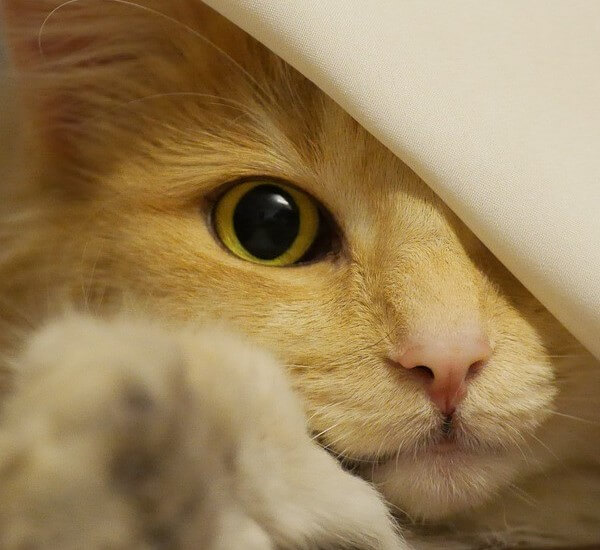
The Norwegian Forest Cat is a naturally occurring breed that originated from the mountainous regions of Norway. They are known for their hunting skills they can manage to climb steep rock faces with the locals referring to them as the “skogkatt” or forest cat.
They are mentioned in some Norse legends including one involving the goddess Freya, who is said to have her chariots drawn by these large forest cats.
The breed almost became extinct in the 1940s due to indiscriminate crossbreeding, but was revived by enthusiasts by introducing a breeding program. They were made Norway’s official national cat by King Olaf V during the 1950s.
How can I tell if my cat is part Norwegian Forest Cat?
Aside from their large size, you can tell a cat has Norwegian Forest Cat blood by looking at the shape of its head, eyes, and ears.
Norwegian Forest Cats have triangular-shaped heads with a nose profile that runs straight down from the ridge to the tip of the nose. They have almond-shaped eyes and their ears can have lynx tips or tufts at the end.
Ragdoll history
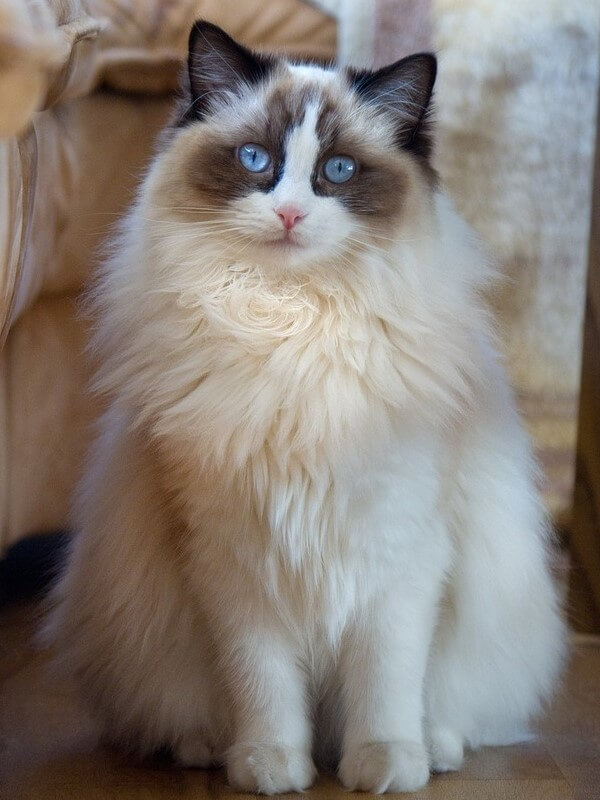
The Ragdoll was developed in Riverside, California by Ann Baker during the 1960s. The originator of the breed is a non-pedigreed female white cat named Josephine, who was crossed with several Burmese-like cats that produced kittens with distinct point coloration and placid temperaments.
Baker later named the breed Ragdoll because it tended to go limp when carried and formed her registry called the International Ragdoll Cat Association (IRCA).
In the 1970s, to make the breed more mainstream and also due to Baker’s strict rule of not allowing the breed to be registered in other associations, several members of IRCA broke ranks with the developer. The Cat Fanciers’ Association recognized the Ragdoll as an official breed in 1998.
RECOMMENDED: British Shorthair Ragdoll Mix (Complete Guide)
What two breeds make a Ragdoll cat?
The matriarch of the Ragdoll, named Josephine, was an Angora-like cat that was crossed with either Burmese or Birman-like cats.
How do you tell if my cat is a Ragdoll mix?
A Ragdoll mix may possess a colorpointed coat with a light-colored body coat that can be cream or white that has dark-colored extremities found in the face, ears, paws, and tail.
Norwegian Forest Cat vs Ragdoll
The main difference between Norwegian Forest Cat and Ragdoll is that Norwegian Forest Cat can come in any color or pattern including tabby, tortoiseshell, and smoke while Ragdoll mainly has a color point coat with a light body coat and darker extremities.
CHECK OUT: Ragdoll Tabby Mix (Complete Guide)
Do Norwegian Forest cats get along with Ragdolls?
Yes, Norwegian Forest Cats and Ragdolls can get along swimmingly since both breeds are friendly and gentle.
Are Ragdoll Norwegian Forest Cat recognized by cat registries?
No, this Ragdoll Mix cat is not recognized by cat registries, such as the Cat Fanciers’ Association (CFA) or The International Cat Association (TICA). It’s because they are not purebred cats with a standard set of physical and temperamental qualities.
Norwegian Forest Cat Mixed with Ragdoll physical appearance
You can expect the Ragdoll Mixed with a Norwegian Forest Cat to have a long, thick coat. Some may have the double coat of the Norwegian Forest Cat and some will have a minimal undercoat that sheds less.
The head shape is equilateral where all sides are of equal length with either pronounced cheeks or not. Eyes are round or almond-shaped with a slight slant. Ears are medium in size with rounded tips that can have lynx tips. Eye color can be blue, green, copper, or gold.
Ragdoll and Norwegian Forest Cat Mix size, height, and weight
Both the Ragdoll and the Norwegian Forest Cat are one of the larger domesticated cats around. So, you can expect these Ragdoll Mix cats to be more sizable than the average domestic cat breeds.
Wegie Ragdolls can reach an adult weight of around 20 pounds and span a length of up to 20 inches from nose to tail. They also mature much slower which can take up to 4 to 5 years before they achieve their full size.
| Gender | Height | Weight |
| Male | 11 – 12 inches | 14 – 20 pounds |
| Female | 9 – 10 inches | 10 – 15 pounds |
Ragdoll Norwegian Forest Cat Mix coat colors and types
The Norwegian Forest Cat Ragdoll Cat Mix comes in an array of colors and patterns. They can inherit the colorpoint pattern found in Ragdolls with a light-colored body and darker extremities.
They can also be solid in color such as black, white, blue, red, and cream. Other patterns include calico, tabby, tortoiseshell, smoke, shaded, and cameo.
READ NEXT: White Ragdoll Cat (Complete Guide)
Tuxedo Ragdoll Norwegian Forest Cat Mix
Tuxedo Ragdoll Norwegian Forest Cat Mix presents a combination of black and white on the coat with white spotting typically around the face, chest, and legs. The bi-color can also be a combination of white with other colors such as blue, cream, or red.
DON’T MISS: Black And White Ragdoll Cat (Complete Guide)
Norwegian Forest Cat Ragdoll Mix personality and temperament
Wegie Ragdolls inherited both their parent’s gentle and friendly personalities. They have a dog-like disposition that enjoys following their family around and has a docile temperament.
This mixed breed however may either acquire the more independent nature of the Norwegian Forest Cat or the needier behavior of the Ragdoll that demands more attention.
Do Ragdoll Norwegian Forest Cats make great family pets?
Yes, Ragdoll Norwegian Forest Cats are a great addition to most families. They are affectionate and get along well with kids that can adapt pretty well to most situations due to their gentle personalities. Wegie Ragdolls are also comfortable with other cat-friendly pets and exhibit little to no aggressive behaviors.
Norwegian Forest Cat Mixed with Ragdoll training
You can expect this Ragdoll Mix breed to be very intelligent and inquisitive making them fairly easy to train. Be sure to employ positive reinforcement techniques, such as treats and petting, to keep them motivated to follow you.
They are suitable to be litter-trained as early as 4 weeks old and taught basic commands at 7 weeks of age.
Ragdoll and Norwegian Forest Cat Mix exercise requirement
Most Ragdoll Mix breeds tend to be lazy because of their Ragdoll parentage preferring a more sedentary lifestyle. This is in sharp contrast to the Norwegian Forest Cats that have a moderately active disposition.
Aim to exercise your Wegie Ragdoll with at least 30 minutes of physical activity daily that can be split into 2 sessions. This way, their tendency to be obese will be greatly reduced.
RELATED: Best Cat Tree For Ragdolls (Reviews & Top Picks)
Ragdoll Norwegian Forest Cat Mix grooming and cleaning
Grooming is an important part if you want to share your life with a Mix Ragdoll. Setting a regular grooming schedule will keep her coat pretty and tangle-free. Plus, grooming allows you to spot parasites and skin problems before these issues worsen. Here are some grooming tips for you:
Bathing
Unless your cat gets dirty and smelly, there is no need to bathe often as this will only dry out her skin and coat. If bathing is already necessary, choose a mild and organic shampoo that is formulated for felines.
CHECK OUT: Do Ragdoll Cats Like Water?
Brushing
To keep those unsightly tangles at bay, use a wide-tooth comb. You can also brush her coat with a slicker brush to minimize shedding.
Teeth Cleaning
Gum and tooth problems are common among cats and this is why we recommend that you establish a regular mouth-cleaning routine. An enzymatic toothpaste works best for your feline friend because it is safe to swallow and it prevents tartar and plaque formation.
Nail Trimming
Those long and sharp nails can hurt you and damage your furniture. So, maintain the length of her nails by using a small clipper for cats. It’s a good idea to smoothen the edges with a nail grinder.
Ear/Eye Cleaning
One of the proven ways to reduce eye and ear infections is through regular cleaning. Get a moistened cotton ball and wipe away those eye boogers and excessive ear discharge.
| Grooming Needs | Grooming Frequency |
| Bathing | 1x/month |
| Brushing | 3x/week |
| Teeth Cleaning | 3x/week |
| Nail Trimming | 2x/month |
| Ear/Eye Cleaning | Check weekly |
Do Norwegian Forest Cat Ragdoll Mix shed a lot?
Yes, a Norwegian Forest Cat Mix sheds her coat moderately. However, shedding gets heavier during the change in season which occurs in springtime and autumn.
But don’t worry, because you can keep your home clean, and free of cat litter, cat hair, and dander by using a vacuum cleaner with a HEPA filter.
WANT MORE INFORMATION? Check out Do Ragdoll Cats Shed? 7 Ways To Shed Less! and Do Ragdoll Cats Sneeze A Lot? 15 Reasons & How To Help
Are Ragdoll Norwegian Forest Cat Mix hypoallergenic?
No, Ragdoll Norwegian Forest Cat Mix are not hypoallergenic.
All cats, regardless of hair thickness and length will one way or the other cause an allergic reaction to sensitive persons.
Blame it on the Feld1 protein, it is produced by all cats and is present in their saliva and sebaceous glands.
But did you know that simply turning on an air purifier with a HEPA filter will clear away allergens to keep the quality of indoor air healthy for everyone?
RELATED: Are Ragdoll Cats Hypoallergenic?
Ragdoll Norwegian Forest Cat food and diet
Felines are obligate carnivores, which means they have no need for fresh produce like fruits and grains. Instead, a high-protein diet is an ideal food for a Ragdoll Norwegian Forest cat.
We recommend a mixture of dry and canned food to increase your cat’s hydration levels.
Ragdoll Norwegian Forest Cat Mix common health issues
While a Ragdoll Norwegian Forest mixed cat is generally healthy, it is still possible for her to inherit some of the health problems of her parents.
The good thing is that there is now a cat DNA test kit that can provide you with precise information about the possible genetic disease of your feline friends:
Here are five (5) health issues your Ragdoll Norwegian Forest Cat Mix can be susceptible to:
1. Polycystic Kidney Disease (PKD)
This is caused by a defective gene wherein the affected kitties are born with minuscule cysts that grow and multiply in their kidneys. The symptoms such as excessive thirst begin to show at around 7 years of age.
2. Hypertrophic Cardiomyopathy (HCM)
A heart disease that affects the muscles of the heart, HCM causes labored breathing and lethargy.
3. Glycogen Storage Disease
An inherited condition that is caused by an enzyme deficiency. Muscular tremors and persistent fever are 2 of the common symptoms.
4. Retinal Dysplasia
A progressive eye disease that causes the degeneration of the retina. The disease will eventually later on cause blindness.
5. Pyruvate Kinase Deficiency (PKD)
This is an inherited disease that is caused by a lack of enzymes that leads to the reduced production of red blood cells. Anemia and weakness are 2 of the common signs of PKD.
Ragdoll Norwegian Forest Cat Mix lifespan
Provide all the essential needs of your cat, you can expect her to live an average of 12 to 18 years.
Norwegian Forest Cat Mixed with Ragdoll breeders
Are you thinking of driving to a pet shop near you to look for a Norwegian Forest mix cat? Hold off on that thought because cats that are sold in pet shops may be products of irresponsible breeding practices.
Instead, search online for the websites of responsible breeders who have these qualifications:
- Responsible breeders have affiliations with cat organizations such as TICA.
- Responsible breeders DNA test their breeding cats against gene-related diseases like PKD. If found positive, they do not use these cats so as not to pass on the disease to their offspring.
- Responsible breeders ensure that the kittens for sale have received their initial set of core vaccines and been dewormed.
Ragdoll Norwegian Forest Cat Mix kittens
The ideal time to separate Mix Ragdoll kittens from their mothers is at 12 weeks of age. If the kittens are separated early on, there is a risk of developing aggressive behaviors and other behavioral problems.
While you’re waiting for your kitty to reach her ideal age to come home to you, prepare the necessary things she’d be needing like the following:
- Cat carrier
- Kitty bed
- Litter box
- Litter
- Food and water bowls
- ID tags
- Grooming supplies
- Toys
- High-quality cat food
Norwegian Forest Cat Ragdoll Mix price
The average cost of a Norwegian Forest cat is between $800 and $2,000. Adult cats are normally sold at a lower price because the demand is not as high compared with kittens.
Places to find Ragdoll Norwegian Forest Cat Mix for sale
To get a healthy Ragdoll Norwegian Forest Cat Mix, the best option is to look for responsible breeders. We found 2 breeders whom we believe are worth exploring for Ragdoll Norwegian Forest cat mix for sale:
- A TICA-registered cattery located in the USA, Cosmic Ragdolls (cosmicragdolls.com) has available kittens that are raised in an underfoot environment for socialization purposes. The breeder has adult cats for sale, too.
- Gudrun’s Place Norwegian Forest Cats of Canada (gudrunsplace.ca) offers interested buyers with DNA-tested, healthy, and well-socialized kittens for sale.
Similar Ragdoll Norwegian Forest Cat Mix
If you’re interested to learn about other Norwegian Forest cat mixes, an equally adorable Norwegian Forest cat mix may fancy you such as the one below:
Norwegian Forest Cat Ragdoll Maine Coon
Being a product of 3 large cats, a Norwegian Forest cat Ragdoll Maine Coon mix is a huge cat itself. This mixed breed also sports a long coat that sheds throughout the year. The coat color comes in various colors which can be two-toned or three-toned like tortoiseshell.
DON’T MISS: Tortie Ragdoll Cat (Complete Guide)
Maine Coon vs Ragdoll vs Norwegian Forest Cat
While these 3 cats belong to the large cat breed category, with the Maine Coon being the biggest of them all, there are some behavioral differences among them.
A Maine Coon is vocal while a Ragdoll and a Norwegian Forest cat are both quiet. If the Maine Coons and the Norwegian Forest cats are moderately active, such is not the case with the Ragdoll which is notorious for its laziness.
You may also like: Are Ragdoll Cats Talkative Or Vocal?
Ragdoll Norwegian Forest Cat Mix: Pros and Cons
To help you decide if this is the mixed cat breed for you, here are some of the pros and cons:
| Pros | Cons |
| Docile personality | Requires a lot of space due to its size |
| Smart | Not hypoallergenic |
| Great with children | Prone to certain diseases |
| Affectionate | Tendency to have separation anxiety |
| Wide variety of coat colors and patterns | Not ideal for warm climates |
| Moderate exercise needs | Expensive to maintain |
Is the Norwegian Forest Cat Ragdoll Mix right for me?
If you are interested in owning a large cat that has a more dog-like personality that exhibits great affection and friendliness, then the Norwegian Forest Cat Ragdoll Mix may be the right breed for you.
Related Questions
The cat breeds that are best mixed with a Ragdoll are those that have a similar gentle and charming nature. A great example is the Birman Cat which is known for its friendliness and similarly sports the colorpoint coat and blue eyes of the Ragdoll.
The key distinction between Norwegian Forest Cats and Ragdolls is that the former can exhibit any color or pattern, such as tabby, tortoiseshell, and smoke, whereas Ragdolls typically have a colorpoint coat with a lighter body and darker extremities.
DISCLAIMER: THIS WEBSITE DOES NOT PROVIDE MEDICAL ADVICE
The information, including but not limited to, text, graphics, images and other material contained on this website are for informational purposes only. No material on this site is intended to be a substitute for professional veterinary advice, diagnosis, or treatment. Always seek the advice of your veterinarian or other qualified health care provider with any questions you may have regarding a medical condition.
Resources:
https://everycat.org/cat-health/cardiomyopathy-in-norwegian-forest-cats/
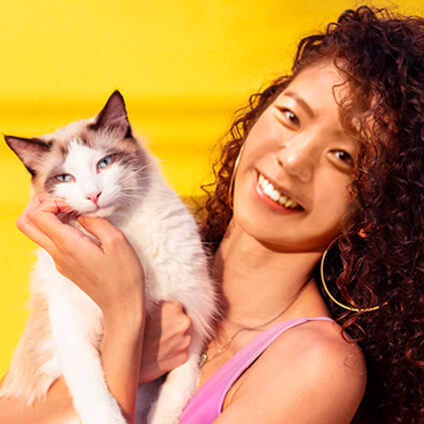
With over five years of specialized experience as an animal writer, my expertise lies in cat nutrition, health, behavior, grooming, and training. I am dedicated to delivering helpful and informative content that caters to the well-being of our feline friends. My primary goal is to empower pet owners with knowledge and ensure our feline companions thrive in health and happiness. In my free time, I love volunteering at local cat rescue centers.
